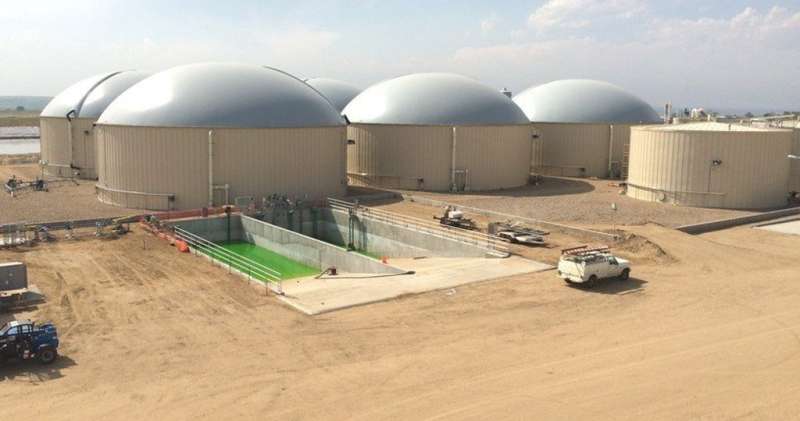Bio-methane transforms from landfill waste to energy source

Methane produced by manure and food waste in landfills doesn't have to go to waste. Using anaerobic digesters, the gas can be harnessed for energy.
Methane is far more damaging as a greenhouse gas than carbon dioxide—25 times more so. The gas, which is produced by decomposing organic materials in the absence of air, not only traps heat efficiently but is also a health and safety hazard because it's so concentrated in landfills. About half of the landfills in the US collect and burn methane, mitigating the danger but still contributing to atmospheric methane and carbon dioxide levels. Animal manure decomposition on farms is the main contributor of methane emissions in agriculture.
Repurposing that wasted gas is the focus of a new study published in the journal Environmental Progress and Sustainable Energy by chemical engineers from Michigan Technological University. Specifically, they examined the carbon footprint of anaerobic digestion—composting organics without air—which can be used to redirect methane into a usable energy source.
"We found that bio-methane produced through anaerobic digestion emits far less than its fossil natural gas equivalent," says Sharath Ankathi, the paper's lead author and a PhD student at Michigan Tech. Studying each product's carbon footprint is a way to assess its social, environmental and economic impact—in other words how sustainable it is—which Ankathi says is "defined as helping current generations without compromising their needs or the needs of future generations."
Life Cycle Assessment
Ankathi's faculty advisor is David Shonnard, a professor of chemical engineering who leads the Sustainable Futures Institute on campus. They also collaborated with James Potter from AG Energy USA, and together the team focused on a case study of a biogas facility in Colorado. Their primary tool is a life cycle assessment (LCA).
An LCA can be applied to any human activity in order to determine environmental impacts in a comprehensive manner. In other words, an LCA examines the life of an activity. The activities may include business operations, such as services or goods, and may also be used to understand behaviors and choices at the individual and household levels. Sometimes an LCA is cradle-to-grave, sometimes it looks at just a portion of a product's life cycle.
In this case, Ankathi and Shonnard dug into the piles of organic waste coming into Colorado's Heartland Biogas Facility LLC and assessed the process that turns food waste from restaurants in Denver and manure from dairy farms near the facility into bio-methane, an energy source. This is the first study that looks at the entire anaerobic digestion life cycle of both food waste and dairy manure and that includes avoided landfill emissions.
Waste to Power
Methane emissions account for 11 percent of the country's overall greenhouse gas emissions; both manure and food waste are significant contributors. In the US, 97 percent of food waste is buried and decomposes in landfills while manure is most commonly placed in open-to-the-sky lagoons, storage pits, slurries, deep beds for cattle and swine, or poultry high-rise houses. Dairy cows are the most significant contributor to methane emissions from manure decomposition.
Anaerobic digesters take those uncovered piles of sitting manure and place them in large covered tanks. Bacteria are used to break down the solids and liquids; the key is ensuring the breakdown doesn't come in contact with oxygen. Food waste on its own is not as efficient in anaerobic digestion, so blending it with manure solves two problems with one process. The end products are a liquid digestate, which can be used for fertilizer or industrial uses, and bio-methane, which can be used like natural gas.
In their analysis, the team found that bio-methane produced from all available food waste and dairy manure in the US annually would offset about .74 percent of annual natural gas demand. The bigger savings come in mitigated methane emissions; around 100 Heartland-scale anaerobic digestion facilities can eliminate about 0.41 percent annually of the approximately seven billion tons of overall US greenhouse gas emissions.
The challenge to mitigate more is still big, although Shonnard says tackling the problem like an engineer will help make it manageable.
"Engineers handle complexity by simplifying it into different stages of the life cycle and focusing their efforts on one piece at a time," Shonnard says. "LCAs enable us to look at a product's environmental impact, it can help focus our attention on how to improve the performance over the whole life cycle. This perspective encourages turning wastes generated at the end of a product's life into useful products, as shown in this study."
More information: Sharath K. Ankathi et al. Carbon footprint and energy analysis of bio-CH4 from a mixture of food waste and dairy manure in Denver, Colorado, Environmental Progress & Sustainable Energy (2017). DOI: 10.1002/ep.12762
Provided by Michigan Technological University



















